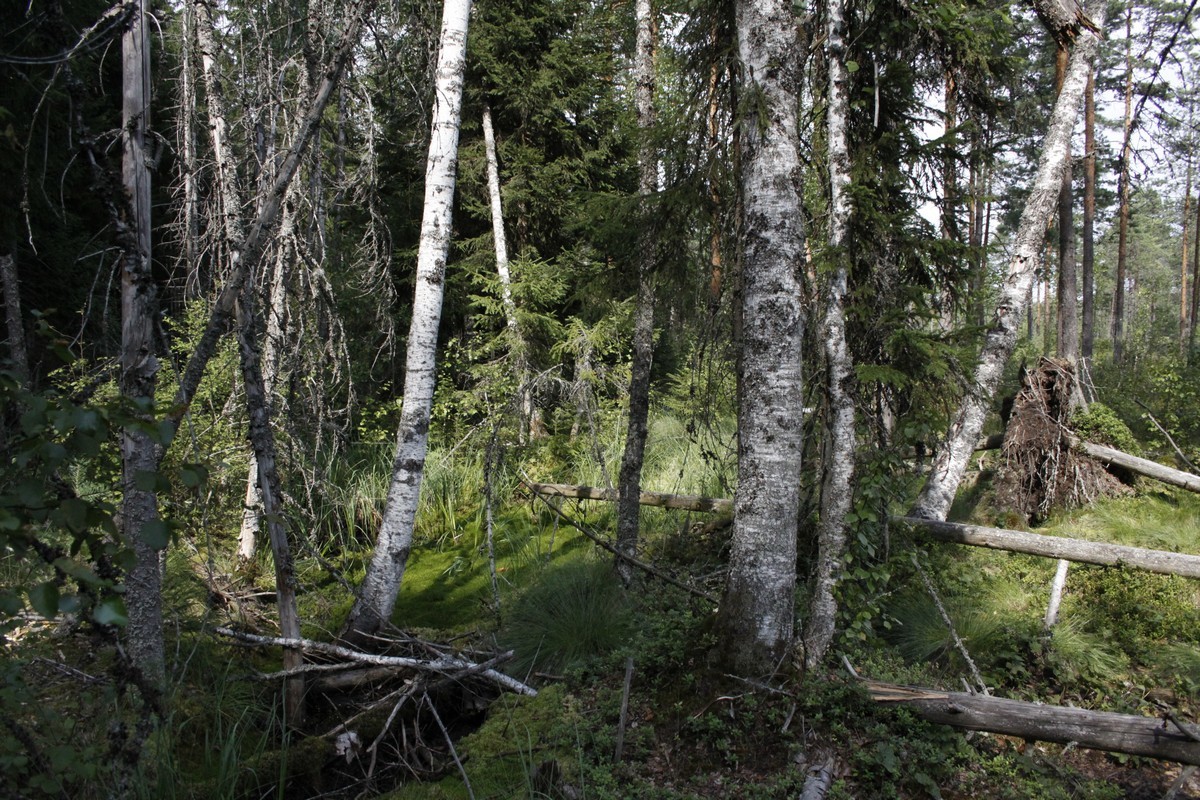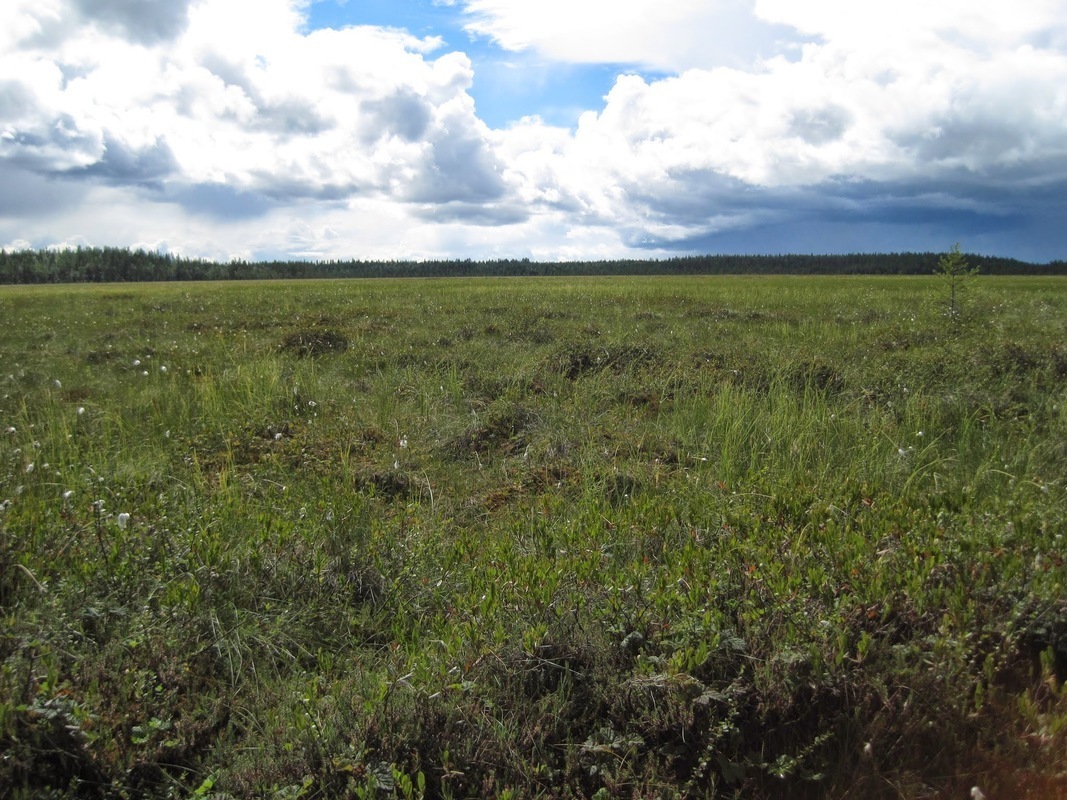14. Finnish ecosystems
Contents
14.1 Different ecosystems
The conditions of the non-living or abiotic environment determine what kind of an ecosystem will develop in a certain area. These factors include things such as climate conditions and soil type. For example, the Finnish climate and geography is suitable for the development of lakes, bogs, and taiga forests.

Different Finnish ecosystems: Oligotrophic and eutrophic lakes, dry and wet taiga forests, pine swamp, and open bog.
This chapter examines the most common types of Finnish ecosystem. The ecosystems common to the Baltic Sea will be examined in the following chapters. Forests and bogs will be examined in greater detail in the following (8th grade) biology course.
14.2 Oligotrophic and eutrophic lakes
Lakes nutrients from the rivers and brooks that flow into them. The most important nutrients for producers, such as plants, are nitrogen and phosphorous. These are essential in order for plants to grow. Lakes can be classified into two trophic lake types according to their nutrient concentration. Most Finnish lakes can be classified to be oligotrophic lakes. These lakes have a low nutrient concentration. In contrast, euthropic lakes are rich in nutrients.

An oligotrophic lake (left) and an eutrophic lake (right).
The table below lists the characteristics of oligotrophic and eutrophic lakes.
| Oligotrophic lake | Eutrophic lake |
|---|---|
| few nutrients | a lot of nutrients |
| clear water | opaque water |
| low levels of plant growth | high levels of plant growth due to plentiful nutrients |
| few plants | a lot of plants |
| fish typically salmonids, such as vendaces and lavarets | fish typically cyprinids, such as roaches |
| bottom-dwelling organisms few, but from many different species | a lot of bottom-dwelling organisms, but only from few different species |
| few birds; for example fish-eating birds such as black-throated loons | a lot of birds, such as dabbling ducks |
| human activity a threat to the lake's ecosystem | eutrophication transforms oligotrophic lakes into eutrophic lakes |
14.3 Finnish forests
The wetness of the soil and the amount of nutrients in it determine what kind of a forest will grow in a certain area. This is due to the fact that different trees have adapted to different kinds of environments. For example, spruce thrives in a wet and nutrient-rich soil, whereas pine favours a dry soil that is low in nutrients.
Taiga forest in Seitseminen National Park. The picture is also suitable for viewing with VR glasses! © Juha Salminen
Sand and gravel are well-draining soil types, resulting in a dry growing environment. As water passes through the soil, it also transports nutrients through it. As a result, nutrients will not accumulate in these types of soil. This kind of a soil type will usually result in a dry dry taiga forest. Its most common tree species is pine. The ground is usually covered with lichens, lingonberries, and heather.
Dry taiga forest.
If the soil consists of more water-absorbent till, it will also store up more nutrients for plants. This type of soil will result in a wet taiga forest. The most common tree species in this kind of forest is spruce. The undergrowth is rich in different kinds of plants, such as blueberry, grasses, May lilies, and arctic starflowers. The oldest forests of this type are often shady, and their undergrowth consists mostly of mosses.
Wet taiga forest.
If the soil is even more water-absorbent and rich in nutrients, the area may well develop into a broad-leaf forest. Broad-leaf forests are rich in plant life. The fallen leaves of broadleaf trees are transformed into nutrient-rich soil when decomposed. In the past, many Finnish broad-leaf forests were transformed into fields and farmland. Only seven percent of Finnish forests can be classified as broad-leaf forest.
Different broad-leaf tree species, such as birch, are common to this forest type. If the forest is located in Southern Finland, it can also include so-called "noble" broad-leaf trees, such as oaks, maples, and elms. The undergrowth of a broad-leaf forest is usually rich in plants, mostly containing different shrubs and grasses.
Broad-leaf forest.
| Characteristic | Dry taiga forest | Wet taiga forest | Broad-leaf forest |
|---|---|---|---|
| Soil type | sand, gravel | till | soil |
| Amount of water | low | high | good |
| Amount of sunlight on the ground level | high | low | high in spring, low in summer |
| Most common tree species | pine | spruce | broad-leaf trees |
| Undergrowth | lichens, mosses, lingonberry | mosses, grasses, blueberry | shrubs, grasses, etc |
| Animals | few | spruce forest species | plenty |
| Spread | all of Finland | all of Finland | Southern Finland |
Parks are not technically forests, but they are a common forest-like ecosystem in urban environments.
Park plants and animals. Viinikka park in Tampere. The picture is also suitable for viewing with VR glasses! © Juha Salminen.
14.4 Bogs
Trees can grow in some bogs. Pine swamp is the most common Finnish bog type. Like their name suggests, pine swamps are distinguished by the pine trees that grow sparsely in this bog type. Other plants common to pine swamps include birch, and heather.

Pine swamp. The soil type of a bog consists of peat. It is formed of decomposed moss. Peat moss is common to all bog types. Pine swamps contain pine trees. They suffer from the low nutrient concentration of the bog. Bogs accomodate relatively little animal life.
Another type of bog that includes trees is the spruce bog. It is a bog type rich in plant life. Spruce trees and some broad-leaf trees grow in spruce bogs.

Spruce bog. The soil of a spruce bog consists of peat. Trees can grow their roots through the thin peat layer into a nutrient-rich soil. Birch and spruce are the most common tree species in a spruce bog. The undergrowth of a spruce bog is rich. The most common plants are moss, dwarf shrubs (such as blueberry), cloudberry, and wood horsetail.
Open bogs are free of trees. The thick peat layer of the bog has accumulated during the course of millenia. It consists of decomposed peat moss. Water puddles can also be found in the middle of open bogs.

Open bogs accomodate no trees. The peat layer can be tens of metres deep. Grasses and mosses are common to open bogs. Many open bogs of Southern and Central Finland are thicker at the centre than at their edges.
14.5 Fells
Fells are the mountaineous environments of Northern Finland and Lapland. Fell tops have no trees due to the cold and harsh climate conditions.
The high peaks of Lapland are at the mercy of strong winds and freezing cold. As trees do not thrive in these conditons, other organisms have even less protection from the harsh climate. Because of this, the plant life of fells has adapted by growing along the ground. The animals are also small, and take cover from the harsh environment by sheltering under the snow or in rocky holes.

Halti is Finland's highest peak.
Fells also contain other kinds of vegetation zones. The lowest areas are covered in taiga forest. When one ascends a fell, the taiga forest gives way to white birch. At the tree line, white birch is replaced by the low-growing dwarf birch as the most common plant. In the north, the tree line is lower in elevation than in the south.
14.6 Terminology
- Soil is a term that means the loose ground found above bedrock.
- The plant life of a forest can be divided into layers: tree layer, shrub layer, undergrowth, and ground layer.
- Till is a soil type that consists of rock, sand, and clay.
- Dry taiga forest is a dry forest type where pine is the most common tree.
- Wet taiga forest is a forest type dominated by spruce.
- Broad-leaf forest is a wet and nutrient-rich forest type.
- Peat is poorly decomposed plant waste.
- Pine swamps are bogs that accomodate pine trees.
- Spruce bogs are bogs rich in plant life, with spruce and birch as the most common trees.
- Open bogs are bogs where no trees grow.
- Fells are mountaineous areas common to Northern Finland.
- The tree line is the elevation above which trees do not thrive.

